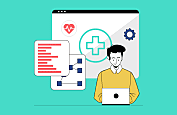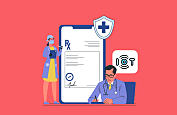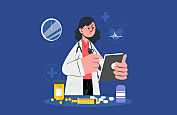
- What is Data Analytics in Healthcare Industry?
- What are the Types of Healthcare Data Analytics?
- How Does Data Analytics Help Healthcare?
- Boosting Productivity with Data Analytics in Healthcare
- Determining the Success of Healthcare Services and Technology Companies
- What is the Future of Data Analytics in Healthcare?
- Conclusion

Data and analytics are essential components for accelerating productivity in the healthcare industry. Health organizations are generating a significant amount of data from diverse sources, including electronic medical records, medical imaging, and wearable devices. However, the great value of this information will be fully realized only when the data is analyzed properly.
The benefits of data analytics in healthcare includes revealing hidden insights in healthcare data, using resources efficiently, and making informed choices - boosting productivity. Data analytics has many healthcare applications, and it personalizes treatment plans, optimizes supply chains and staff, supports medical decisions, and identifies areas needing improvement.
In today's competitive landscape, using data analytics is crucial for healthcare app development desiring to stay ahead. It provides a comprehensive operational view, pinpoints inefficiencies, anticipates trends, and proactively addresses challenges.
In this article, we'll explore how healthcare services and tech firms leverage data analytics in healthcare industry for productivity gains. We'll discuss types, implementation approaches, and data-driven healthcare's future. Utilizing data is key to delivering better care, streamlining operations, and maximizing productivity in this rapidly growing industry.
What is Data Analytics in Healthcare Industry?
The process of big data analytics in healthcare involves analyzing vast amounts of data collected from various sources to discover insights and patterns. In the medical field, there are endless streams of data generated every day from sources such as:
- Electronic health records (EHRs)
- Medical imaging tests (X-rays, MRIs, etc.)
- Genetic and genomic data
- Data from wearable devices tracking vital signs
- Information from mobile apps and telehealth platforms
- Medical claims and billing data
- Clinical trial research data
It not only involves all the data but also comes in structured data, such as the data from EHR, the text data from doctor's notes, as well as from imaging, genomic sequences, etc. The different types of data in healthcare, as well as the variety and volume, make it "big data."
Traditional data analysis tools and databases do not work effectively and faster with big data. Thus, big data analytics skills and systems are designed. These are robust platforms with a better set of software, tools, and algorithms to deal with these huge and intricate data sets easily and in time.
Through the utilization of big data analysis in healthcare, businesses can bring all their data sources together to have a more complete view of their patient populations. They can spot unnoticeable insights like disease patterns, risk factors, effective treatment paths and the like. This data-centric method provides constructive decision-making, recovery prognosis, and event optimization.
What are the Types of Healthcare Data Analytics?
Healthcare data analytics come in a variety of forms. The following are the most popular data analytics subcategories:
- Descriptive analytics: In order to get insights into benchmarks as well as trends, descriptive analytics in the healthcare industry leverages historical patient data.
- Prescriptive analytics: Machine learning is used by prescriptive analytics to suggest a course of action.
- Predictive analytics: Predictive analytics is a technique used in the healthcare industry to estimate and simulate likely future events.
- Discovery analytics: Discovery analytics also makes use of machine learning, just as prescriptive analytics. The distinction is that it makes use of machine learning to analyze clinical data in order to find patterns that offer useful insights.
Each of these types of data analysis in healthcare uses a different analytics technology. These data analytics have real-world applications that can help patients and healthcare organizations.
How Does Data Analytics Help Healthcare?
Data analytics for healthcare is an essential tool in the industry's transformation, thus bringing about informed decision-making, process excellence, and good patient outcomes.
If you want to know some of the most popular uses of data analytics in healthcare settings, scroll through:
1. Managing Patient Health Records: Hospitals and other healthcare facilities are gradually moving from paper-only to digital mode, thus making it possible to extract information from different sources in real time. In the first case, data analytics for healthcare is essential to interconnect huge databases of patients' medical records. It provisionally gives the medical professions collective information on a person's health history and allows personal and precise care.
2. Forecasting Operating Room Demands: Operating rooms, which are costly resources, have to be utilized properly to minimize costs and enhance patient care. With the help of data analytics for healthcare, hospitals are able to know the relationship between different operation room parameters, such as applications of other operations, the number of staff, and patient volumes. This leads to better equipment and staff placement that would reduce wait times and increase throughput.
3. Optimizing Staffing: A copy of the schedule is mandatory for the control of costs and for the timely treatment of patients. Regular staffing is a challenge because the demand for staff is not predictable, as the weather, vacation, or the health status of a sector of the population drive it. Hospital analytics can model staffing levels based on locally significant weather patterns, holiday events, and illness seasons. This method ensures the right number and type of healthcare workers and lets healthcare centers predict the best number of staff by making more precise forecasts.
4. Preventing 30-Day Hospital Readmissions: Sparing hospital visits within the 30-day deadline remains the primary goal of the healthcare sector, which is helpful as it reduces costs and gives the patients the resources needed to care for emergency cases. With the use of data analytics in healthcare, you can recognize models and factors that lead to rehospitalization. This enables the hospitals to target patients with interventions and even keep up with the follow-up care plan.
5. Predicting No-Show Appointments: When patients miss appointments, it leads to losses and schedule disruptions. By analyzing data, patients patterns can predict no-shows accurately. Healthcare facilities can then send reminders and reschedule efficiently.
6. Enhancing Supply Chain and Preventing Fraud: Analytics tracks supply chain metrics and inventory levels and optimizes procurement processes. This ensures a cost-effective supply chain management system for timely delivery of medical supplies. It also enhances cybersecurity by detecting suspicious online behaviour and potential threats. This prevents data breaches and loss of confidential patient information.
7. Reducing Medical Errors: Healthcare can reduce medical mistakes through data analysis. Healthcare data analytics helps spot errors like surgery problems, wrong diagnoses, or medication mix-ups. Catching these issues early allows doctors to fix errors, keeping patients safer. Data insights flag issues deviating from proper procedures.
Boosting Productivity with Data Analytics in Healthcare
We'll focus on five key areas where healthcare services and technology companies will invest to develop more efficient customer service. This will also help translate large masses of healthcare data into positive insights and strategies, thus improving productivity and customer experience.
1. Deploy Different Data Sources in Healthcare
In the healthcare industry, it is very important for companies that operate in the IT sector to have access to different data sources. Their analytical skills would be pointless without the initial data. The data from a diverse group like volume, types, and varieties is what makes it so crucial.
Data that is more diverse and of great quality will usually increase the possibility of finding new insights. Nevertheless, there are still some enterprises that have issues with big data integration because of silos and compartmentalization. Thus, it is difficult to develop effective action plans and make affirmations. One can start by putting together all the pieces of the picture and make it clear by identifying:
- Primary Sources: Electronic medical records, claims, labs, and pharmacies - the main forces that constitute the patient's viewpoint.
- Supplementary Sources: These include patient experiences, environmental influences, contract data, and details of coverage.
2. Centralize Member Records
Healthcare institutions need to organize and give a single and comprehensive picture of each patient that represents their entire history, a ‘single source of truth.’ The importance of data analytics in healthcare can be seen in aggregating and systematically analyzing complex, unstructured patient data.
Healthcare data analytics platforms that can scale have redefined the generation of insights by integrating different sources of records through patient-matching technologies, analytic apps, and common data models. This fosters innovation, whereas interoperability could have become an impediment to the modernization of healthcare data analytics systems.
Enabling providers to offer effective insights based on the currently established norms, healthcare organizations are looking for full data interoperability. Providers should, first of all, put their heads together to come up with a seamless way to integrate third-party data and their internal sources rather than broad interoperability challenges later.
3. Invest in Advanced Analytics
The process of providing a more proactive system of healthcare through data insights calls for the use of technologies like machine learning and natural language processing. It also requires application of the methods of data mining and automated insight generation.
Technological companies working in healthcare have to process data from claims processes, paper records, web-scraped data, etc. Major healthcare organizations continuously gather and translate tremendous datasets to develop real-time analyses or feedback mechanisms to determine payment validities, for instance.
4. Build Multidisciplinary Expertise
Instead of just giving access to patient records/insight and data processing/analytic services, technology providers are also looked upon as business/healthcare experts - therefore, one of the key requirements.
Another technology called enterprise content library will bring together analytics, insights, and context from different industry sectors. Working in isolation, hospitals may fail to notice new patterns and unique information.
Payment integrity requires the merging of medical analytics with claims data to scan the physicians' recommendations and detect whether the treatment was effective or dosing errors were made - a skill most people don’t have.
5. Enable Workflow Integration
Integrating customer insights strategy in the day-to-day business of clients is the best way to make sure the insights are implemented. Without a seamless blend in the staff's daily schedules, the impact insights have on the work process is certainly lessened.
Medical staff need solutions that will allow them to merge information and processes with the whir of a button. Consistently, the integration of the workflow ensures that the latest insights are brought on board.
Determining the Success of Healthcare Services and Technology Companies
Companies operating in the quickly expanding big data and healthcare services and technology market must evaluate themselves in light of five key considerations as the market develops. Suppose your company provides healthcare data analytics services and technology. In that case, you should use the following questions to gauge if it can be qualified as a top healthcare analytics company as well as where it stands in relation to the competition.
1. Have you coordinated your company's growth strategy with the relevant healthcare services and technology sectors of the economy, keeping in mind that various subsegments will expand at distinctly different rates and necessitate special capabilities? What wagers does your strategy make on a successful product-market business model? What is the impact of data analytics in healthcare?
2. Who is or will be paying for your services in the end? What advantages do they gain? How much will they get back? What impact may time and other factors have on the value? How does this fit into their purchasing criteria? Are you willing to share the risk of achieving the desired results with your clients?
3. Have you created a winning platform strategy in fields where you could benefit from growth trends? How will you implement this tactic to multiply your consumer base by 10, 20, or even 100? What strategy do you have to expand in an area that is getting more crowded?
4. How do you intend to set yourself apart from rivals (for instance, by working on the above-mentioned game-changing technology) in order to attract and keep specialized talent? Are you prepared to grow and operate in an "agile mode" across all of your business processes, especially those where you might need to make up for customer or partner capacity gaps?
5. Does your company promote a culture that is centered on insights? Are you able to use your big data analytics in healthcare to its fullest potential in order to improve performance, market focus, and customer intimacy?
What is the Future of Data Analytics in Healthcare?
The future seems very promising and transformational for healthcare data analytics. HEre are the key trends and the future of data analytics in healthcare:
- Artificial Intelligence and Machine Learning: ML and AI in healthcare will play bigger roles, as they can spot patterns and make predictions from huge, complex healthcare data. AI could help with diagnosis, treatment suggestions, patient risk classification, and more.
- NLP: Natural Language Processing (NLP) techniques will allow analytics platforms to get insights from unstructured data like doctor notes, social media, and research papers. This unlocks previously inaccessible data for analysis.
- IoT: Internet of Things (IoT) enabled analytics will rise. Wearables, remote monitoring tools, and IoT healthcare sensors will generate huge real-time patient data streams. Analytics platforms must integrate and understand these continuous data flows. Iot in healthcare will witness a boom.
- Predictive analytics: It will leverage machine learning on vast patient data to enable accurate prediction models. These can forecast risks like diseases, hospital readmissions, treatment effectiveness, and offer valuable preventative and precision care insights.
- Precision Medicine: Data analytics will be key for bringing precision medicine to the mainstream. Analyzing multi-omics data with EHRs and IoT data can reveal personalized disease patterns and optimal treatment paths for each patient.
Conclusion
Healthcare services and technology companies can improve their productivity through data and analytics. It helps in accessing an extensive range of data sources, constructing patient views that are integrated into one central platform, implementing advanced analytics such as AI/ML and blockchain in healthcare, and embedding obtained insights into workflows.
As data keeps growing from mobile apps and wearable devices, healthcare app development companies must get good at data analytics. This skill sets industry leaders apart from others. Healthcare software development companies that make data-driven choices will work better to boost patient outcomes and help stay ahead in healthcare's data-driven future.
Frequently Asked Questions
-
How does data analytics improve patient outcomes?
-
What types of data are used in healthcare analytics?
-
What are the benefits of data analytics in healthcare?
-
What are the challenges of implementing data analytics in healthcare?
-
What role does healthcare data analytics play in personalized medicine?
-
How can data analytics help in managing healthcare costs?
-
What are the ethical considerations in healthcare data analytics?



















